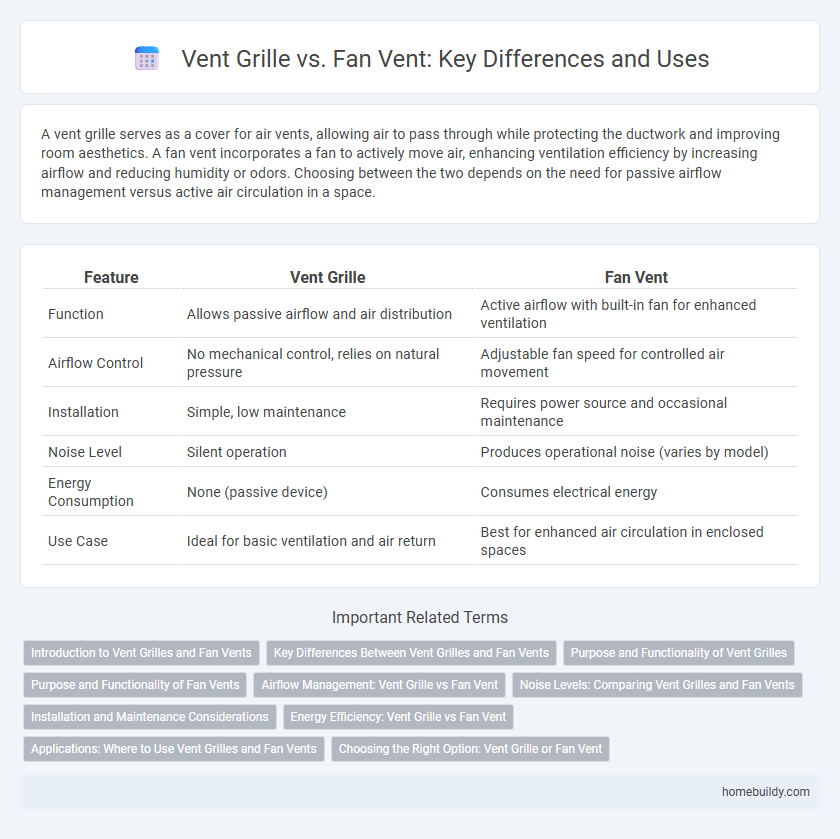A vent grille serves as a cover for air vents, allowing air to pass through while protecting the ductwork and improving room aesthetics. A fan vent incorporates a fan to actively move air, enhancing ventilation efficiency by increasing airflow and reducing humidity or odors. Choosing between the two depends on the need for passive airflow management versus active air circulation in a space.
Table of Comparison
| Feature | Vent Grille | Fan Vent |
|---|---|---|
| Function | Allows passive airflow and air distribution | Active airflow with built-in fan for enhanced ventilation |
| Airflow Control | No mechanical control, relies on natural pressure | Adjustable fan speed for controlled air movement |
| Installation | Simple, low maintenance | Requires power source and occasional maintenance |
| Noise Level | Silent operation | Produces operational noise (varies by model) |
| Energy Consumption | None (passive device) | Consumes electrical energy |
| Use Case | Ideal for basic ventilation and air return | Best for enhanced air circulation in enclosed spaces |
Introduction to Vent Grilles and Fan Vents
Vent grilles serve as passive components designed to cover air ducts, allowing smooth airflow while preventing debris entry and enhancing aesthetic appeal. Fan vents incorporate built-in fans that actively circulate air, improving ventilation efficiency in spaces requiring increased airflow. Choosing between vent grilles and fan vents depends on specific ventilation needs, airflow requirements, and installation settings.
Key Differences Between Vent Grilles and Fan Vents
Vent grilles primarily serve as passive covers for air ducts, regulating airflow while preventing debris from entering ventilation systems. Fan vents, equipped with integrated fans, actively circulate air to enhance ventilation efficiency and improve indoor air quality. The key difference lies in their functionality: vent grilles facilitate airflow without mechanical assistance, whereas fan vents provide powered air movement for targeted ventilation.
Purpose and Functionality of Vent Grilles
Vent grilles serve as essential components in HVAC systems, designed to cover air ducts while allowing air to flow freely between rooms and ventilation systems. Unlike fan vents, which actively move air using mechanical components, vent grilles primarily facilitate passive airflow, ensuring efficient ventilation and air distribution. Their purpose focuses on regulating air direction and protecting duct openings from debris, enhancing overall system performance and indoor air quality.
Purpose and Functionality of Fan Vents
Fan vents actively circulate air by incorporating a motorized fan, enhancing ventilation efficiency compared to passive vent grilles that rely solely on natural airflow. The primary purpose of fan vents is to improve air exchange in enclosed spaces, reducing humidity, odors, and stale air more effectively. Fan vents are essential in environments requiring consistent airflow control, such as bathrooms, kitchens, and HVAC systems, ensuring optimal air quality and comfort.
Airflow Management: Vent Grille vs Fan Vent
Vent grilles regulate airflow by allowing passive air circulation through adjustable slats, optimizing ventilation efficiency without mechanical assistance. Fan vents actively control airflow using built-in fans, enabling precise air movement and enhanced ventilation in enclosed spaces. Choosing between vent grilles and fan vents depends on the need for passive airflow management versus powered air circulation for improved indoor air quality.
Noise Levels: Comparing Vent Grilles and Fan Vents
Vent grilles generally produce lower noise levels compared to fan vents due to their passive airflow design, which eliminates mechanical sounds. Fan vents incorporate motors and blades that generate operational noise, often measured in sones or decibels, potentially affecting indoor acoustic comfort. Selecting vent grilles can be advantageous in noise-sensitive environments where quiet ventilation is a priority.
Installation and Maintenance Considerations
Vent grilles are typically easier to install than fan vents, requiring only basic mounting to cover duct openings without electrical wiring. Maintenance of vent grilles involves simple cleaning to remove dust and debris, whereas fan vents demand more frequent inspection and servicing of mechanical parts to ensure proper airflow and functionality. Choosing a vent grille over a fan vent reduces installation complexity and long-term upkeep costs significantly.
Energy Efficiency: Vent Grille vs Fan Vent
Vent grilles provide passive airflow regulation by allowing air to circulate naturally through ductwork, which reduces energy consumption compared to electrically powered fan vents. Fan vents actively move air using motors, increasing energy use but enhancing ventilation speed and effectiveness in specific scenarios. Choosing a vent grille over a fan vent can lead to lower electricity bills and reduced environmental impact due to its reliance on natural convection rather than mechanical operation.
Applications: Where to Use Vent Grilles and Fan Vents
Vent grilles are ideal for passive airflow areas such as HVAC return air ducts, wall or door openings, and ventilation pathways in residential and commercial buildings. Fan vents actively circulate air and are essential in spaces requiring enhanced air movement or exhaust, including bathrooms, kitchens, and utility rooms where moisture and odor control are critical. Choosing between vent grilles and fan vents depends on specific ventilation needs, balancing airflow efficiency and environmental requirements.
Choosing the Right Option: Vent Grille or Fan Vent
Vent grilles provide passive airflow regulation by covering duct openings, allowing air to circulate naturally without noise or power consumption, making them ideal for rooms requiring consistent ventilation. Fan vents actively boost air movement using integrated fans, effectively improving ventilation in spaces with poor airflow or where enhanced air exchange is needed. Selecting between a vent grille and a fan vent depends on factors such as room size, ventilation needs, noise tolerance, and energy efficiency priorities.
vent grille vs fan vent Infographic

 homebuildy.com
homebuildy.com